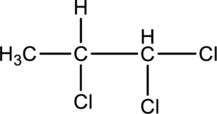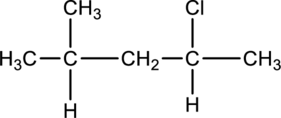
Concept explainers
a.
Interpretation:
For the below compound the chirality centers has to be labeled and number of chiral centers should be determined

Concept introduction:
Chirality center:
When a carbon atom is bonded to four different groups, then that carbon is named as chiral carbon and it is called as chirality center. Generally, the carbon atom contains tetrahedral valency, therefore it bonded to four atoms or molecules. The chiral center is bonded with four different elements or groups. If the single carbon atom is bonded to two or more identical group or atom, then it is also not considered as chiral carbon. In addition to this, if the carbon atom contains multiple bond then it does not able to bond with four different groups then it is not considered to be as a chirality center.
b.
Interpretation:
For the below compound the chirality centers has to be labeled and number of chiral centers should be determined

Concept introduction:
Refer to part “a.”.
c.
Interpretation:
For the below compound the chirality centers has to be labeled and number of chiral centers should be determined

Concept introduction:
Refer to part “a.”.
d.
Interpretation:
For the below compound the chirality centers has to be labeled and number of chiral centers should be determined

Concept introduction:
Refer to part “a.”.
Want to see the full answer?
Check out a sample textbook solution
Chapter 12 Solutions
Principles of General, Organic, Biological Chemistry
- Determine the relationship between the two compounds: A. Same compound B. Enantiomers C. Diastereomers D. Constitutional isomersarrow_forwardConvert each three-dimensional representation into a Fischer projection.arrow_forward3.A carbon atom that is bonded to four different groups is a/an A.achiral center B.chirality center C.symmetrical center D.symmetrical centerarrow_forward
- Optically active one compound. Optically active pair of diastereomers. Optically inactive one compound. Optically inactive pair of diastereomers. Optically active pair of enantiomers. Optically inactive pair of enantiomers.arrow_forwardLocate the stereogenic centers in each compound. A molecule may have one or more stereogenic centers. Gabapentin enacarbil [part (d)] is used to treat seizures and certain types of chronic pain.arrow_forwarda. How many asymmetric centers does the following compound have? b. How many stereocenters does it have? CH3CH-ClCH CHCH3arrow_forward
- Determine the relationship between the two drawings: A. Enantiomers B. Same compound C. Constitutional isomers D. Diastereomersarrow_forwardA compound with two chirality centers is shown (2S,3R)-2-bromo-3-chlorobutane. Convert the structure to the wedge and dash structurearrow_forwardA(n) ________ is an achiral compound that contains chiral centers but is superimposable on its mirror image. A) constitutional isomers B) conformational isomers C) enantiomers D) diastereomers E) meso compoundsarrow_forward
 Organic Chemistry: A Guided InquiryChemistryISBN:9780618974122Author:Andrei StraumanisPublisher:Cengage Learning
Organic Chemistry: A Guided InquiryChemistryISBN:9780618974122Author:Andrei StraumanisPublisher:Cengage Learning

